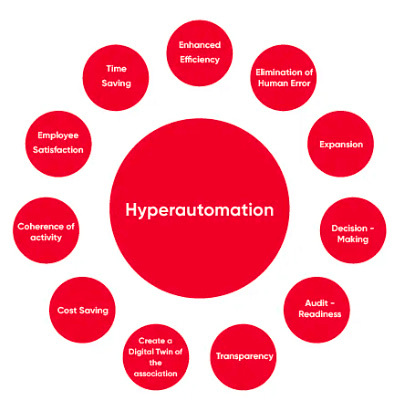With digital transformation constantly evolving to reshape the face of technology adoption, Hyperautomation, a groundbreaking approach is taking center stage. So much is the impact of digital transformation hyperautomation that Gartner, has not only recognized but has identified hyperautomation as one of the top 10 strategic technology trends. In their recent survey, a staggering 85% of respondents declared their intent to “increase or sustain their organization’s hyperautomation investments over the next 12 months.” What’s even more telling is that over 56% are already juggling four or more concurrent hyperautomation initiatives.
Gartner’s verdict is clear: Hyperautomation is no longer a luxury; it’s a prerequisite for survival in the rapidly evolving digital landscape. Outdated work processes, according to Gartner, are now the numero uno workforce issue. This seismic shift signifies that hyperautomation isn’t just a tech buzzword; it’s becoming the lifeblood of organizational resilience and success. It’s not a matter of if but when organizations will fully embrace the transformative power of hyperautomation to not just stay afloat but to surge ahead in the wave of digital evolution.
Understanding Digital Transformation Hyperautomation
At its essence, hyperautomation goes beyond traditional automation. It represents a paradigm shift by not just automating tasks but by elevating human capabilities through the seamless infusion of intelligent technologies. This all-encompassing strategy is designed to automate not only routine processes but also intricate decision-making, creating an organizational environment that is not just efficient but remarkably agile and responsive. Hyperautomation, therefore, becomes the catalyst for unleashing the full spectrum of human potential within the framework of a technologically empowered enterprise.
Key Components
Digital Transformation Hyperautomation is a dynamic synergy of three essential components:
Automation: Comprised of diverse automation programs and tools to execute specific tasks.
Orchestration: The art of assembling various technologies into a comprehensive framework, ensuring seamless integration and coordination of tasks.
Optimization: An additional layer of intelligence enhancing the integration of automation and orchestration processes through continuous learning and validations.
In a typical hyperautomation platform, the process involves:
Connecting Processes: Unifying processes, workflows, and environments on a shared platform for end-to-end automation.
Data Handling: Identifying structured and unstructured data from multiple sources and storing it in a stable database for utilization in various automation procedures.
Outcome Prediction: Forecasting outcomes like efficiency and return on investment (ROI) through data analysis and continuous learning during operation.
Benefits of Hyperautomation

Businesses transform as a result of digital transformation hyperautomation, which streamlines operations by automating manual jobs and getting rid of repeated ones. Many important advantages come with this. It enables businesses to execute jobs quickly, accurately, and consistently. This ultimately lowers expenses and enhances the clientele’s overall experience.
- Enhanced Efficiency: By automating repetitive tasks and optimizing processes, hyperautomation significantly improves operational efficiency, reducing the time required for task completion.
- Improved Accuracy: The integration of AI and ML minimizes errors by learning from data patterns, ensuring a higher level of accuracy in decision-making and task execution.
- Agility and Adaptability: Hyperautomation fosters agility, enabling organizations to adapt swiftly to market changes and technological advancements, staying ahead in a dynamic business environment.
Cost Savings: Automation of routine tasks and streamlined processes leads to cost reductions, allowing organizations to allocate resources more strategically.
Challenges that Circumnavigate Digital Transformation Hyperautomation
While the potential of digital transformation hyperautomation is vast, organizations grapple with significant challenges like security uncertainties, ethical considerations in AI applications, and the imperative for a skilled workforce to navigate and innovate in this dynamic landscape. Many businesses feel ill-prepared for automation initiatives due to issues like incomplete or low-quality data and a shortage of personnel with requisite technological skills. Addressing these challenges requires the implementation of retraining programs, providing organizations with the tools to tackle these demands and devise strategies for optimal goal attainment.
Navigating the ever-expanding and evolving product industry introduces further complexities. Organizations face the daunting task of deciding which products to offer, presenting a considerable challenge. To streamline their product offerings in the saturated market, the industry anticipates numerous mergers and acquisitions, aiming to reduce redundancy and assist clients in more efficiently evaluating potential vendors. This dynamic environment demands a strategic and agile approach from organizations seeking to thrive in the competitive landscape.
Business Areas Impacted by Digital Transformation Hyperautomation
Healthcare Revolution
Transforming healthcare services involves the seamless flow of patient information, medical staff coordination, support, and billing through interconnected domains. Hyperautomation streamlines these tasks, consolidating information and processes onto a unified platform. By expediting healthcare processes, it enables a focus on value-based treatment, freeing up resources, ensuring policy compliance, and enhancing interpersonal reliability.
Retail Innovation
In the retail sector, especially in the realm of e-commerce, digital transformation hyperautomation plays a pivotal role. It elevates front-end processes such as customer interactions and social media content creation. Simultaneously, it collaborates with back-end operations, managing tasks like order fulfillment, billing, and inventory control. By delving into consumer behavior and operational patterns, it leverages data to create a dynamic that optimizes profits and revenue.
Supply Chain Resilience
The disruptions in the global supply chain due to the impact of COVID-19 have posed challenges for every node in the chain. Hyperautomation intervenes by facilitating meticulous planning, seamless data movement, and automated stock management. This proactive approach aids in anticipating delays and taking preventive measures to mitigate extensive disruptions.
Financial Insights
Hyperautomation brings a heightened awareness of the cost implications of tasks, especially in financial domains. An illustrative example is the Department of Accounts Payable (APD), a critical component supporting an organization’s purchasing cycle. By hyperautomating AP activities, including receipt management and purchase order handling, organizations gain a streamlined and organized procurement cycle. This not only enhances efficiency but also provides valuable insights into the financial landscape.
Future Outlook and Potential of Digital Transformation Hyperautomation
As technology continues to advance, digital transformation hyperautomation is poised to become an integral aspect of digital transformation strategies. Organizations embracing this paradigm shift will likely experience a competitive edge, unlocking new possibilities in innovation, efficiency, and customer satisfaction.
Hyperautomation represents more than a technological evolution; it is a holistic transformation in how businesses operate and harness the power of automation technologies. Embracing digital transformation hyperautomation is not just a choice but a strategic imperative for organizations aiming to thrive in the digital age.



